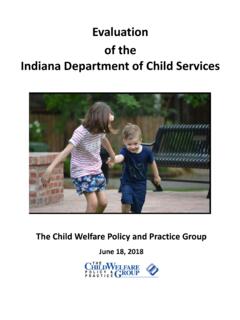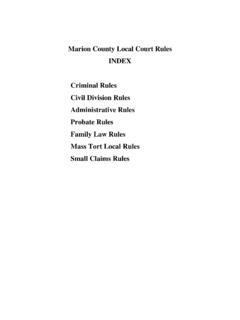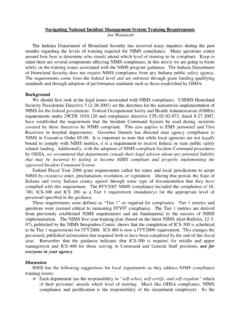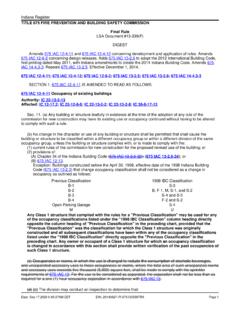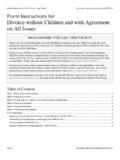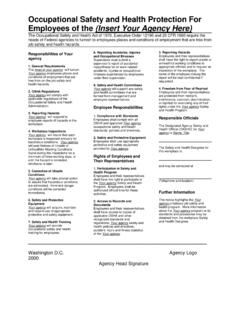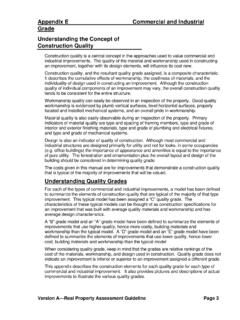Transcription of Indiana Food & Beverage Tax - IN.gov
1 Indiana food &. Beverage Tax Local Government Guide Updated September 2020. Indiana Department of Revenue A Local Government Guide to Indiana food & Beverage Tax Welcome to the Indiana Department of Revenue's (DOR) Local Government Guide to food and Beverage (FAB) tax. This document includes the following: What is FAB? How does my county/municipality enact a FAB? When should we contact DOR about implementing a FAB? What are DOR's responsibilities? What are the county/municipality responsibilities? What are the steps after passing a FAB ordinance? How to use the FAB Payee Report Additional Resources DOR Contact Information What is FAB? FAB applies to transactions, in counties/municipalities that have enacted this tax type, in which food or beverages are furnished, prepared or served by a retail merchant for consumption at a location or on equipment provided by a retail merchant for consideration (payment).
2 This includes food sold in a heated state or heated by the retail merchant or if two or more food ingredients are mixed or combined by a retail merchant for sales as a single item. It also includes food or beverages served by a retail merchant off the merchant's premises. A transaction involving food sold with eating utensils provided by the retail merchant, including plates, knives, forks, spoons, glasses, cups, napkins or straws, is subject to FAB. Taxable transactions include: food sold and served by a retail merchant performing catering activities;. food sold at a deli counter in a grocery store that is cooked or heated on the premises of the retail merchant; and Where the seller provides eating utensils, including plates, knives, forks, spoons, glasses, cups, napkins or straws.
3 Transactions not subject to tax include: Sales of food that is only cut, repackaged or pasteurized by the seller. Sales of eggs, fish, meat and poultry requiring cooking by the consumer. FAB does not apply if the transaction is exempt from sales tax. For more information on what qualifies for FAB and sales tax, please refer to General Tax Information Bulletin #203 and Sales Tax Information Bulletin #29. For catering: FAB is based on where the food is provided, not the business location of the caterer. Marketplace facilitators that facilitate the sale of food or beverages by connecting sellers of those items with purchasers on an online marketplace must register to collect FAB in all adopting jurisdictions from which they facilitate such sales. A marketplace is generally considered any forum that connects buyers and sellers for the purpose of making retail transactions (IC ).
4 A marketplace facilitator is generally considered to be a person that operates a marketplace and collects payments or provides access to payment services (IC ). For more information on marketplace facilitators, see 1. Taxable transactions of marketplace facilitators are sourced to the location of the seller, not the location where the food is delivered. For example: A meal delivery company with a popular app that connect several different restaurants in Marion County and Hamilton County with customers in those counties is a marketplace facilitator. A customer orders food on the app from a restaurant in Marion County to be delivered to Hamilton County. FAB would need to be collected by the meal delivery company at the Marion County rate (where the restaurant is located).
5 Counties can choose to administer FAB themselves. Most counties have chosen to delegate FAB. administration to DOR. Currently, all tax returns and remittances for FAB are filed with DOR with the exception of Johnson County. Tax returns and remittances for FAB in the City of Greenwood, which is within Johnson County, are required to be filed with DOR effective March 1, 2020. Marketplace facilitators are required to submit FAB directly to DOR. How does my county/municipality enact a FAB? Once the county/municipality decides the need for additional funding through FAB, they will need the support of their local legislator. The county/municipality will also need to have documentation to display the need for additional funding. The legislator will then introduce a bill for consideration during the legislative session.
6 Legislation may include requirements for the county/municipality to pass an ordinance or specify the duration FAB will be collected. After legislation supporting a county/municipality FAB has passed through the legislative process and been signed into law, the local government entity needs to pass an ordinance to adopt the tax. It's helpful to reach out to DOR early in the process to ask any questions and ensure proper passage of the ordinance. When should we contact DOR about implementing FAB? According to IC 6-9-27-3, the fiscal body of the county/municipality which adopts FAB must immediately send a certified copy of the ordinance to DOR. DOR's setup process takes approximately 120 days. Please see What are the steps after passing a FAB ordinance? for more information.
7 What are DOR's responsibilities? When administering FAB, DOR assumes the following responsibilities: Maintaining FAB guidance and resources for taxpayers and counties. Providing tools for businesses to register and to assist with registration questions. Implementing controls to ensure due diligence in the registration process. Assisting with educational seminars for counties and municipalities. Providing detailed report or portal access to retrieve data to counties on a regular basis if a confidentiality agreement is in place. Monthly tax collection and enforcement efforts if FAB is not paid. 2. What are the county's/municipality's responsibilities? Properly adopt FAB and notify DOR immediately, at least 120 days before the enactment date. Execute data sharing documents and provide financial and contact information as needed.
8 Identify businesses that are not properly registered and/or remitting FAB by accessing county records or industry codes through DOR. Notify businesses of their filing and registration requirements. Provide preliminary information to the taxpayers and direct them to DOR for additional information. Continue to inform new and existing businesses of their FAB obligations and direct them to DOR's FAB resources, as needed, for more information. If you have an active confidentiality agreement, use the FAB Payee Report provided biannually by DOR to see businesses registered for and paying FAB. Keep the county assessor information on parcel addresses and municipality boundaries current and accurate. Submit any changes to the State immediately to ensure businesses are registered for the proper tax rates.
9 What are the steps after passing a FAB ordinance? 1. Contact DOR's FAB administrator to get the process started. A completed confidentiality agreement is required to receive tax data. 2. Provide funding information to DOR to ensure funds are allocated properly. 3. Contact the State Auditor's Office to set up a FAB account where funds will be deposited. 4. Once the FAB local ordinance has passed, work with the FAB administrator and DOR to notify affected businesses that may need to collect FAB a sample letter is attached. 5. Compare the DOR provided FAB Payee Report against other business lists ( , health department) to confirm businesses are registering correctly. 6. After FAB is enacted, notify the Indiana Department of Local Government and Finance to update all Geographic Information System (GIS) data when annexations or any changes to boundaries occur.
10 How to obtain and utilize the FAB Payee Report? The fiscal officer and individuals designated by the officer may obtain access to payment information for the individual businesses subject to FAB in their jurisdiction. This information can be used to assist the Department with contacting the businesses to give them the tools to be compliant, developing a plan to assess businesses that are not compliant after contact, and contacting DOR. with enforcement requests with non-compliant businesses. In order to access this information, the fiscal officer must enter into a confidentiality agreement with DOR. For more information, contact (317) 234-5436, ext. 78320. Additional resources General Tax Information Bulletin #203 food and Beverage Tax: INTIME User Guide: Sales Tax Information Bulletin #11 Application of Sales Tax to Restaurant Owners Including Fast food Operations and Caterers: Sales Tax Information Bulletin # 29 Sales of food : 3.
